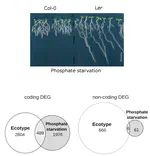Conservation and evolution of lncRNAs in plants
Functional insights in one species can often be transferred to another by exploiting evolutionary conservation, notably via sequence homology. A major difficulty to apply such approaches for lncRNAs is their poor sequence conservation. Indeed, the functions of lncRNAs are lower sequence constraints than for coding genes and at best only short stretches of sequences have been found to be conserved. Therefore, their homology is poorly estimated with current methods of sequence conservation research. The molecular functions of lncRNAs have been characterized in few cases, both in animals and plants, typically within a single species. The generalisation of their mode of action remains unclear.
Therefore, the understanding of the evolution of lncRNAs might help to identify conserved characteristics. This later will be crucial for the identification of common mechanisms of actions.
Using two ecotypes of Arabidopsis thaliana that respond differentially to phosphate starvation, we analyzed in roots full transcriptome changes including coding genes, ncRNAs and small RNAs, after a short-term phosphate deprivation. Thousands of previously uncharacterised ncRNAs were identified whose encoding DNA is highly conserved between the two ecotypes. Despite this strong sequence conservation, half of the detected ncRNAs were transcribed in only one of the two ecotypes. In contrast, 90% of the protein-coding genes were expressed similarly in the two ecotypes during the phosphate starvation. Therefore, lncRNAs are a major source of variation between species and ecotypes while the proteome is highly conserved.
However, functional homologous lncRNAs, even without sequence or structure homology, can be identified through conserved binding to orthologous proteins. For example, we show that the human lncRNA UPAT which interact with DNA methylation regulator UHRF1, can interact in Arabidopsis with its hortholog VIM1, like the Arabidopsis lncRNA APOLO, despite the lack of sequence homology between the two lncRNAs.

